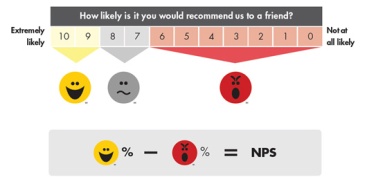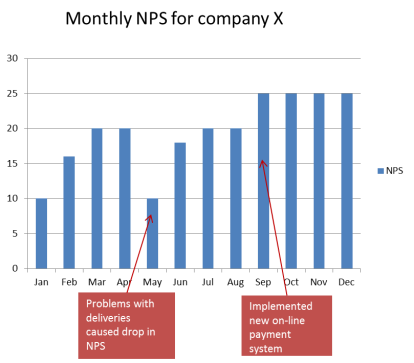Do you know how loyal your customers are to you?
In my last blog , I talked about the importance of talking to your customers and how to implement an account management strategy for your top ten customers.
This week’s blog is going to look at another aspect of engaging with your customers through customer feedback, in particular using the Net Promoter Score to assess the loyalty of your customers.
There are three types of customer feedback you can actively use:
- Net Promoter Score
- In-depth interviewing of your key customers (different from the key account conversation you have with them)
- More general customer feedback that you can get from all your customers.
I will cover the latter two in future blogs.
You will also get passive customer feedback for example from your sales team or front-line customer service staff and you should encourage your staff to let you know about any issues, suggestions or complaints.
Customer feedback
When I was the marketing director of a software testing consultancy, I used to have a running battle with our sales people as I was very keen on getting feedback from our customers. Not only about what they thought we did well, but where they thought we could improve. This horrified the sales team – why on earth would I want to go looking for bad news stories?
My argument was that surely you want to find out the bad stuff before it’s too late and whilst you can still do something about it?
‘Your most unhappy customers are your greatest source of learning’ – Bill Gates
I am terribly unBritish and don’t hesitate to complain if I feel I have been let down by an organisation. How that company treats my complaint directly affects whether or not I will use them again. The ones that hold their hands up immediately and admit they have failed me and do something positive to turn the situation around get my undying devotion, or at the very least, they get to keep me as a customer. A complaint can be turned to your advantage. As long as you deal with it promptly and correctly.
But I’d far rather not complain in the first place or to have the issue dealt with before it blew up leaving me exhausted and enraged with trying to get someone/anyone to listen to me.
Sometimes an apology is all it takes.
Getting new customers is expensive!
Last week I shared the fact that it costs six to seven times more to get a new customer than it does to keep an existing one.
The benefits of keeping a customer far outweigh trying to find new ones all the time;
- They are less sensitive to price changes
- They are less likely to move to a competitor
- They are much more likely to continue spending with you
- And of course they are more likely to refer you to others (thus reducing your marketing spend as this is a zero cost activity)
So we should be spending more effort on talking to our customers. Getting feedback from your customers is one way to help you achieve this.
Using the Net Promoter Score
This is the new buzz measure. It’s a way of measuring your customers’ loyalty. This is believed to be a more important measure than customer satisfaction as a way of establishing if a customer is likely to buy from you again.
Here are the four steps you need to take:
-
You ask one simple question:
How likely is it that you will recommend us to a friend or colleague?
And asking them to give a score from 0 to 10 where 0 is extremely unlikely/never and 10 is extremely likely.
The scores are divided into three broad categories
Promoters – those who score 9 or 10. They are highly likely to be loyal customers who will continue using you and refer you to others
Passives – those who score 7 or 8. They are satisfied customers, but who are likely to shop around and can be switched to your competitors.
Detractors – those who score 0-6. These are your unhappy customers and who are likely to complain either to you or to their friends and have the potential to damage your brand resulting in a negative impact on your growth.
You collect the data over a month asking all customers that one question.
-
Calculate your NPS
In order to calculate the score, you ignore the scores of the Passives and then simply take away the percentage of the Detractors from the percentage of the Promoters giving you’re your Net Promoter Score or NPS.
Example NPS
Promoter score – 25%
Detractor score – 5%
Net promoter score is 25-5 = 20

The average industry score is 15 so that would be your benchmark and obviously you want it to be higher than that. Apple has a truly remarkable NPS of 72!
-
Regularly collect the information
This not a one off exercise, this is an on-going activity to enable you to track the trends to see if you are improving or worsening month on month. Each month you gather the data and work out the NPS. If you can get this question on-line, then it should be a simple task of working it out with some technical wizardy.
-
Track the score
It’s a very easy metric to track graphically and to share with your staff. And you can use it to assess any change in practice to see if it is having a positive impact on your customers. Here’s a hypothetical one:
And of course there is a step 5 – which is to take action if the trend starts a downward decline (and celebrate if it continues to increase month on month).
So, with this measure, you are looking for the trend (in hopefully an upward trajectory).
It’s a measure that is increasingly asked of businesses up for sale so it’s good to have built up some history to show.
It’s by no means a perfect measure and there are those who would argue it’s not the be all and end all measure that its proponents claim.
And you will use the feedback from the NPS in conjunction with other feedback you are getting so hopefully you will be getting a holistic view of how your customers perceive you.
Nonetheless, it is a simple to implement measure that certainly gives you a good idea as to a pattern of how you are perceived by your customers and one that can be used to good effect internally with your staff.
If you want to know more about how to build your relationships with your customers, please drop me an email – karen@thechameleonguide.com
http://www.thechameleonguide.com


